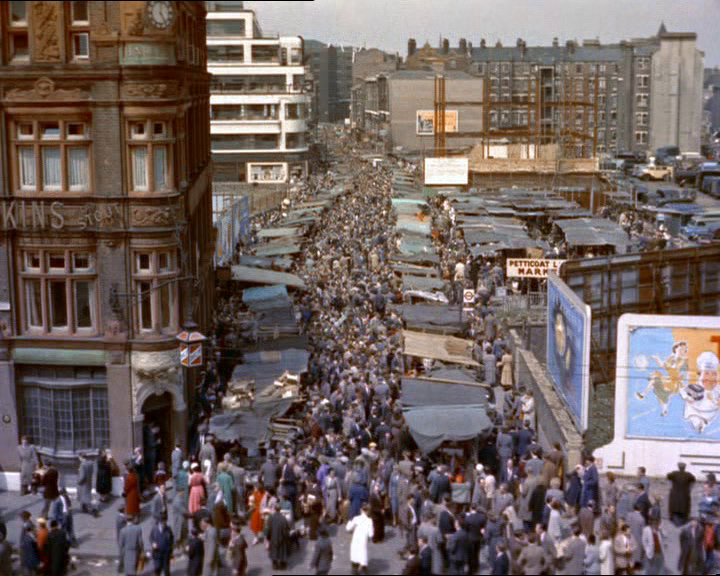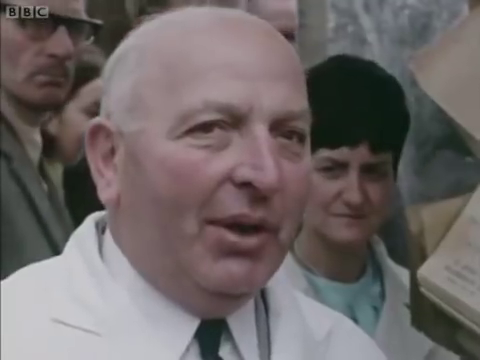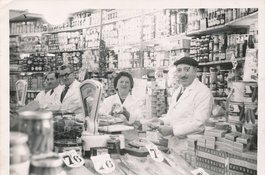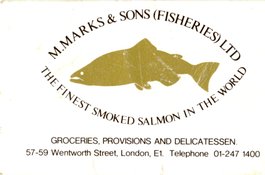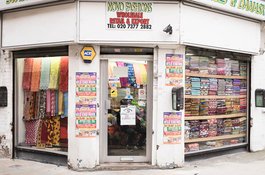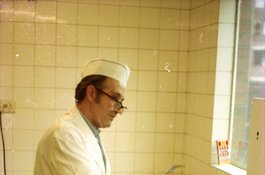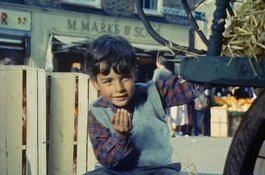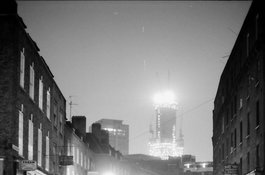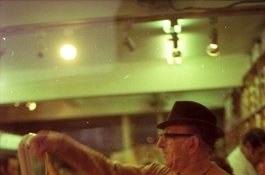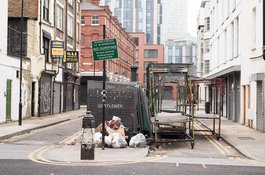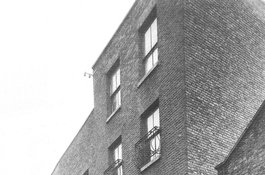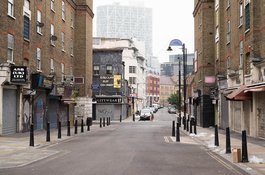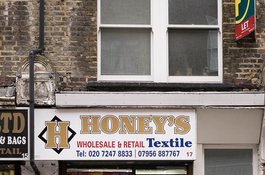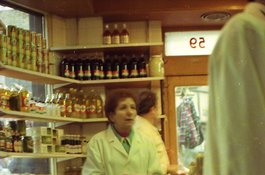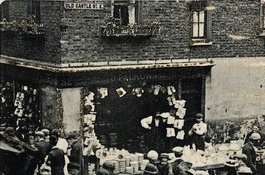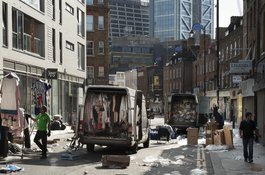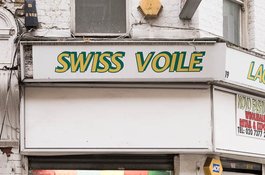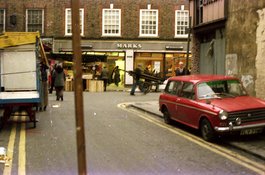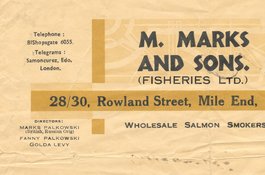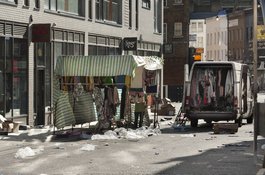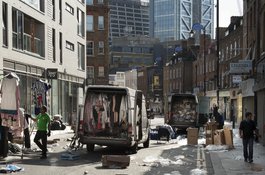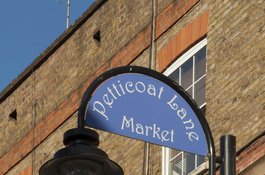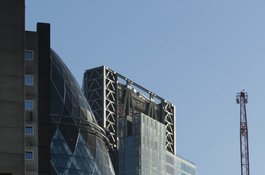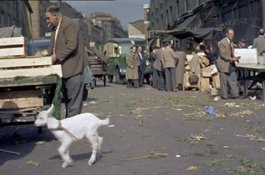Petticoat Lane's early history
Contributed by Survey of London on Aug. 3, 2020
Petticoat Lane ‘is not what it used to be’. This lament has echoed through
recent decades, as demography and shopping habits continue their perpetual
churn, but it is older. An aura of nostalgia has clung to Petticoat Lane from
its earliest times. In the 1590s John Stow bemoaned the transformation of
Hog Lane, as it was then generally known: ‘This Hogge lane stretcheth North
toward Saint Marie Spitle without Bishopsgate, and within these fortie yeares,
had on both sides fayre hedgerowes of Elme trees, with Bridges and easie
stiles to passe ouer into the pleasant fieldes, very commodious for Citizens
therein to walke, shoote, and otherwise to recreate and refresh their dulled
spirites in the sweete and wholesome ayre, which is nowe within few yeares
made a continuall building throughout, of Garden houses, and small Cottages;
and the fields on either side be turned into Garden plottes, teynter yardes,
Bowling Allyes, and such like, from Houndes ditch in the West, so farre as
white Chappell, and further towards the East.’
This suggests both that the line of the street was built up between 1550 and
1600 and that the hinterland remained undeveloped. Stow is inexact, but it has
been suggested that the reference to tenteryards refers to those created on
the City side in the 1570s. Bowling is recorded in the 1530s in a nearby
Whitechapel garden, and in the 1590s William Megges had a bowling alley at his
great house to the east of Petticoat Lane.
Hog Lane to Petticoat Lane
The name ‘Petticoat Lane’ was in use by 1586, when two houses in ‘Petticote’
or ‘Pettycote’ Lane were to be searched in connection with the Babington plot
that led to the execution of Mary, Queen of Scots. One of these houses was
that of John Gage (b. 1563), the recusant grandson of Sir John Gage, Queen
Elizabeth’s sometime chamberlain, and younger brother of Robert Gage who was
executed for his part in the plot.
Petticoat Lane appears to owe its name to a different kind of illicit
activity. Hog Lane, even when still so called in the late sixteenth century,
was the location of a well-known ‘disorderly’ house owned by John Holland,
part of a ‘mobb’ with brothels dotted around London. In a pamphlet of
1591, Thomas Nashe (as ‘Adam Fouleweather’) wrote that ‘if the Beadelles of
Bridewell be careful this summer it may be hoped that Peticote Lane may be
less pestered with ill aires then it was woont: and the howses there so cleere
clensed, that honest women may dwell there without any dread’. The
following year, Robert Greene relayed a fictional tale of a confidence trick
or ‘cross bite’ in a ‘Trugging house’ in ‘Petticote Lane’. In 1596 the
libertine-turned-Catholic, Thomas Lodge, poured scorn on an imaginary ‘lord of
all bawdy houses, & Patron of Peticote-lane’.
A similar imputation of general disreputability occurs in 1601 in Thomas
Middleton’s pamphlet The Penniless Parliament of Threadbare Poets which
postulates as an implausible scenario that ‘men shall be so vent'rously given
as they shall go into Petticoat Lane and yet come out again as honestly as
they went first in’. There is a more specific suggestion that Petticoat Lane
was a haunt of sexual vice in a pamphlet by Samuel Rowlands, based on the work
of Robert Greene, about a ‘whore’, who, in a common trope, had tried to
facilitate theft from a client in her lodging ‘which was in Peticote
Lane’. The use of the word ‘petticoat’ for a prostitute and the
substitution of ‘Petticoat Lane’ for ‘brothel houses’ in different editions of
Middleton’s work have also been noted. The suggestion has further been made
that the ‘Garden houses’ referred to by Stow were, in fact, these
brothels. In 1632 Donald Lupton opined that Petticoat Lane and Rosemary
Lane (another former Hog Lane that gained notoriety as a clothes market)
housed populations of women who ‘traded on their bottom’.
Such commentary does not constitute a dispassionate archival source, but while
the accounts are undoubtedly embroidered for sensational effect, these
allusions to a specific street, by several different authors, did not come
from nowhere. They are sufficiently numerous, and consistent with late
sixteenth-century Bridewell court records, which show Aldgate as one area
where prostitution was concentrated, to allow the inference that the street’s
name derived from the lewd associations of ‘petticoat’ rather than,
anachronistically, from the area’s later popularity as a locus of trading in
second-hand clothes. That must be noted because a literal interpretation
of the word ‘petticoat’ has been conflated with the beginnings of the street
market. No such link is necessary.
What is not specified in these sources is what part of Petticoat Lane, which
stretched from the junction with Whitechapel High Street north almost to
Bishopsgate Street, is referred to in the allusions to bawdy houses. In Ben
Jonson’s The Devil is an Ass, first performed in 1616, the character of
Iniquity suggests he will ‘lead thee a daunce, through the streets ... Downe
Petticoate-lane, and vp the Smock-allies’, which suggests an area further
up the lane in Spitalfields, the location of Smock Alley. Other early
references to ‘Peticote Lane’ merely as a street name occur in 1602
(specifying only that it is ‘in London’) and more precisely in 1604, when
property, probably an inn, ‘on the east side of Petticoat Lane’, was held of
Sir Thomas Bodley by John Wright, the innholder at the Crown in Aldgate High
Street at his death in 1607. Little can be said about the lane’s early
residents. In the 1750s William Maitland noted that the Whitechapel end of
Petticoat Lane was ‘not mighty well [affluently] inhabited. Those of the most
account are Horners, who prepare Horns for other petty Manufacturers.’
This had been the case for nearly a century. Banished from the City, the
noxious trade had concentrated around Petticoat Lane. The most substantial
horner was George Harrison, resident in Petticoat Lane by 1666 until his death
in 1706. He held several leases on the east side of Petticoat Lane around
Tripe Yard and Swan Court, including that of his own house with a high rental
value in 1693 of £50, as well as other leases in Old Montague Street and
elsewhere in East London. Other houses of reasonable size, clustered in
the centre of the Whitechapel stretch of Petticoat Lane, were occupied by
horners in the late seventeenth and early eighteenth centuries, including
William Axtell (d. 1690), Edward Edwards (d. 1727), William Layton (d. 1728)
and John Abraham (1700–67). The only other substantial resident of this
period seems to have been Edward Lloyd (_c._1620–96), a ‘merchant … and late
of Mary Land, planter’. Lloyd was an ambitious Puritan emigrant who had
returned to England in 1668 and died in Petticoat Lane in possession of
thousands of acres and many slaves in Maryland. He was resident in Black Bell
Lane in a ‘Great Howse’ with a garden and orchard from 1689 to the end of his
life.
Petticoat Lane to Middlesex Street
The process of ‘pestering’ with tenements and courts that Stow bemoaned took
off in Petticoat Lane around the time that the customs of the Manor changed in
1617, and proceeded apace throughout the seventeenth and eighteenth centuries.
When William Browne acquired a Boar’s Head Yard holding in 1621, he already
held land in Tripe Yard, a narrow alley that eventually connected with the
north end of Boar’s Head Yard to occupy together more than a third of the
Petticoat Lane hinterland between the High Street and Wentworth Street, with
access to both the High Street and Petticoat Lane.
By the 1670s there were more than 200 houses on the Whitechapel section of
Petticoat Lane and the alleys and courts leading off it. Of those recorded
fewer than twenty per cent had four or more hearths; more had only one.
Typical perhaps of the two- or three-hearth houses was that leased in Boar’s
Head Yard in 1669 to the horner William Axtell, whose larger principal
dwelling fronted the lane. It was of brick, of four storeys including a
cellar, with only one room on each floor. Hollar’s aerial ‘Surveigh’ of
the post-Fire City of 1667 stretches as far as this corner of Whitechapel, and
shows in a schematic but realistically representative manner a continuous line
of two and three-storey mostly gable-fronted houses of modest width along
Petticoat Lane. By 1676, there were thirteen courts or alleys off Petticoat
Lane on the Whitechapel side, including minor but proper streets, Three Tun
Alley, Black Bell Alley (on the line of New Goulston Street) and Horseshoe
Alley.
Apart from horners and the poor, Petticoat Lane’s closed-off back alleys
provided a home for religious nonconformists. There was a meeting house by
1723, perhaps much earlier, on part of the site of the Boar’s Head Theatre. It
passed from Independents to Anabaptists around 1765, on to Calvinists in the
early nineteenth century, and finally became a synagogue, with stables
beneath, until demolition around 1882.
Despite rebuilding and renaming, this dense topography carried on as a locus
of poverty, disease and crime, often, as ever, in brothels. In 1725 Petticoat
Lane was given as an exemplar of a place a ‘boarding school miss’ would be
ashamed to admit was home. A large open area at the end of Black Bell
Alley, marked ‘Blackguard’s Gambling Ground’ on Horwood’s map of the 1790s,
might be identified with a court called the Gaff, where, it was said in 1818,
‘Jews used to play at pitch and toss’.
As Petticoat Lane’s population increased, public houses were established on
its east side. The earliest was the Black Bell on the corner of Black Bell
Alley, present by the mid seventeenth century and later just the Bell, which
pub survives in rebuilt form. Another was the King of Prussia (sometimes the
King of Prussia’s Head), on the Wentworth Street corner by 1767, rebuilt in
1868 but falling to road widening around 1881. The Black Lion adjoined by 1750
and met the same fate. These places were reputed to be haunts of receivers of
stolen goods. The notoriety of the name ‘Petticoat Lane’ saw it replaced,
very gradually, over the nineteenth century by Middlesex Street – it was part
of the county boundary. The new name was first used in 1805 for the part of
the street between Whitechapel High Street and Wentworth Street, but it was
not until the 1830s that it seems to have taken hold, even for legal or
official use. The blandness of the new name coupled with the familiarity
of the old name, meant that even in the 1890s there were references to
‘Middlesex Street (late Petticoat Lane)’ and ‘Middlesex Street, better known
as Petticoat Lane, Whitechapel’. By the end of the nineteenth century the
whole street to Bishopsgate was Middlesex Street. In a final turn of the
Petticoat Lane wheel, one of the last enterprises in Boar’s Head Yard was a
temporary refuge for fallen women, opened in 1860 in an initiative by the Rev.
Samuel Thornton of St Jude’s Church. There
‘sixty-four young women — mostly fallen, some in danger — nearly all from the
neighbourhood, have passed through the institution; … This excellent
institution is in some degree self supporting, the inmates earning money by
washing, mangling, and needlework.’
The whole of Whitechapel’s Petticoat Lane/Middlesex Street frontage was
cleared for road widening and its alleys for slum clearance in 1880–3 for the
Goulston Street Improvement.
Petticoat Lane Market
Contributed by Survey of London on Aug. 3, 2020
The origins of Petticoat Lane’s street market are obscure, and its antiquity
has been much exaggerated. John Strype, Stow’s successor as a London historian
who was born on Petticoat Lane, did not mention a market in the early
eighteenth century, nor is there any evidence to indicate a significant
presence of market trading in the street before about 1760. While the origins
of the street name do not lie in the clothing trade, for reasons already
given, there were clothing markets not far away by the time the name Petticoat
Lane came into use. This has contributed to historical conflations since the
nineteenth century. As ‘Petticoat Lane’ was a shorthand for prostitution
around 1600, so Houndsditch, to the west, was for clothing. Ben Jonson refers
to it in Every Man in His Humour, first performed in 1598: ‘Where got’st
thou this coat? … Of a Hounsditch man, Sir, one of the devil’s near kinsman, a
broker.’ By the mid eighteenth century a City triangle bounded by
Houndsditch, St Mary Axe and Leadenhall Street hosted a thriving market in new
and secondhand clothes, another Rag Fair, as on Rosemary Lane.
A feature of these markets was the ‘old clothes man’, a recognised type of
itinerant street hawker, always on the move, selling and soliciting stock, and
almost invariably Jewish. While there is no evidence of an established street
market in Petticoat Lane, there are hints that street trading of some sort
might have been taking place there by the 1760s, and that the traders were
Jewish. Whitechapel’s Paving Commissioners ordered the setting up of pitching
places or porters’ stands at the Whitechapel High Street end of Petticoat Lane
in late 1771. The stories that made it into the press were bleak. A man called
Levi, ‘a dealer of old cloaths’, hanged himself in his lodgings in Petticoat
Lane, Whitechapel, in 1766; Solomon Porter, ‘an old Cloathes-man’ who also
lodged in Petticoat Lane, was hanged for his part in a burglary in 1771; and a
gang of thieves conveyed their ‘Plunder to a noted Jew (a Receiver of stolen
Goods) in Petticoat Lane’ in 1778.
Reports of Petticoat Lane as thick with pickpockets suggest crowds if not
markets. In 1789 a public meeting called on magistrates to assist in
‘extirpating a notorious gang of thieves and pickpockets, who have long been
suffered to annoy and plunder the peaceable inhabitants of that neighbourhood
… Petticoat Lane is a very considerable thoroughfare … and certainly would
become more so were it rendered safe for the public to pass and repass.’
The mutable and mobile character of the area’s street markets is evident from
accounts of prosecutions of traders in Cutler Street, leading east out of
Houndsditch towards Petticoat Lane. In 1820 ‘Four old cloathsmen were charged
… with obstructing the highway, and establishing an old cloaths market in
Cutler Street, Houndsditch … from two o’clock until four each day, the street
was blocked with Jews and old cloaths … as soon as [the dealers] were moved
from one end of the street they were seen crowding together at the other, and
their baggage was all spread upon the pavement with the greatest speed.’
The market in what was already becoming Middlesex Street may have arisen as a
further spilling eastwards of the Houndsditch clothes market.
Laxness in use of the name ‘Petticoat Lane’ does not help clarification. In
1839 it was reported that: ‘The origin of the term “Rag Fair”, held in
Petticoat Lane, as Cutler Street is called, can easily be traced to the
commodities exhibited for sale.’ Cutler Street and Harrow Alley were
perhaps the conduits by which the clothes market did become established in
Middlesex Street, but quite when is hard to say. In 1830, a report of a court
case (written entirely for comic effect) related the theft in ‘the Market in
Petticoat Lane’ of ‘a pair of inexpressibles, value 2_s_’. The wife of the
accuser, Moses Levi, described the market: ‘Petticoat Lane Exchange is
conducted with the greatest regularity – five or six hundred people jostle one
another about all day – that she considered quite regular – (Laughter.)’
After this date reports of the market in Petticoat Lane increase, featuring
stolen goods and general sharp practice, usually couched in comic terms that
rely on Jewish and, sometimes, Irish stereotypes.
Henry Mayhew supplied much greater definition in 1849. His colourful
description, widely quoted, explains the topography of Petticoat Lane,
indicating that it did, inter alia, occupy ‘Petticoat-lane proper’
(Middlesex Street): ‘Petticoat-lane is essentially the old clothes district.
Embracing the streets and alleys adjacent to Petticoat-lane, and including the
rows of old boots and shoes on the ground, there is perhaps between two and
three miles of old clothes. Petticoat-lane proper is long and narrow, and to
look down it is to look down a vista of many-coloured garments, alike on the
sides and on the ground.’
Mayhew’s full account goes on to illustrate the difficulty in distinguishing
between the expanding street display of shops and a market with fixed hours of
operation, stall-holders operating from barrows independently of shops.
Hierarchical distinctions were made between shops, street traders with fixed
stalls, and itinerant vendors, pedlars and hawkers, who traded on the hoof.
While there had been some increase in the numbers of poor Irish immigrants in
the old-clothes trade, the itinerant vendors remained predominantly
Jewish.
Petticoat Lane’s status as a ‘Sunday market’, arising from its Jewishness,
became a focus of attention in the 1850s. Henry Ker Seymer MP reported that in
Petticoat Lane there was a ‘regular fair’ on Sundays between eleven and one
o’clock. He argued that ‘the violation of order and decency which there
prevailed’ meant that it should be suppressed. A fellow Tory MP, Robert
Carden, agreed, having visited on a Sunday morning and found ‘an assemblage of
some 10,000 or 12,000 people’. A difficulty was that half of the street was in
the City, half in Middlesex. It became apparent that for the City, the market
had become ‘almost a legalised nuisance’, tolerated ‘in order that they might
get rid of a similar nuisance which at that time existed in more important
thoroughfares’. It was also pointed out that it was invidious (and
implicitly anti-Semitic) to single out Petticoat Lane for condemnation when
trading was going on elsewhere on Sundays. Daniel Samuel of 32 Middlesex
Street (on the City side) explained: ‘if you would please come into Petticoat
Lane on Saturdays you would see the Sabbath kept, – the closing of all shops,
a cessation of all business.’ Further, for the poor, who mostly worked
six days a week, Sunday was often the only day for food shopping. George
Gordon of the National Sunday League wrote in support of the Petticoat Lane
traders and against the anti-Semitic grain, though perhaps as idealising as
others were scornful: ‘I saw nothing objectionable in this poor man’s bazaar
not the least violation of the peace … This unassuming locality is free from
the fashionable vices of adulteries, murders, and robberies … In certain parts
I have seen jewellers, &c, expose their valuables for sale, which at first
made me tremble for their safety; but such is their confidence in the sterling
honesty of the unwashed multitude that the religious and moral characters of
Duke-street, Houndsditch, and Middlesex Street are beyond reproach.’
Petticoat Lane market continued, with occasional increased police presence,
and by 1871 not just on a Sunday. A reporter then estimated vendors to number
around 700 and the press of customers, ‘from all parts of London’, at 10,000.
For a non-Jewish readership, the repeated tropes were the cheapness of goods,
the presence of criminals and the ‘foreignness’ of vendors and customers:
‘This Sunday morning spectacle … is one of the most sickening of all the
unadvertised sights of London. … the behaviour of those who congregate here is
a ruffianly swagger, while the constant din serves only to remind you of a
Jew’s quarter in a continental town’.
In 1880, a visitor detected that Petticoat Lane was not as busy as it once had
been, and that more of the clientele was not Jewish. But the market was
about to receive substantial boosts. Road widening at the south end made an
immediate difference to available space and then there was the impact of mass
Jewish immigration from the Pale of Settlement following the pogroms of the
early 1880s. When Charles Booth embarked on his exhaustive study of the Life
and Labour of the People in London in 1889, he began in the East End, just as
the Whitechapel murders (Jack the Ripper) generated wider fascination. The
descriptive tone is little different from that of the previous forty years –
‘a medley of strange sights, strange sounds, and strange smells’, but this
account provides a clearer sense of the street topography, ‘lined with a
double or treble row of hand-barrows, set fast with empty cases, so as to
assume the guise of market stalls. Here and there a cart may have been drawn
in, but the horse has gone and the tilt is used as a rostrum when the salesmen
with stentorian voices cry their wares’, and the goods on offer, the ‘cheap
garments, smart braces, sham jewellery, or patent medicines. ... Other stalls
supply daily wants – fish is sold in large quantities – vegetables and fruit –
queer cakes and outlandish bread.’ It also suggests again that the demography
was changing: ‘In nearly all cases the Jew is the seller, and the gentile the
buyer; Petticoat Lane is the exchange of the Jew, but the lounge of the
Christian.’ Booth testifies as well to a further eastwards shift, with mention
made of market stalls in Brick Lane, and the animal market in Sclater
Street.
The renewal of the 1880s is also evident in a report on London markets from
1893, which stated that Petticoat Lane ‘is probably the largest street market
in London’, but also that in ‘its present condition the market is not more
than about 10 years old: before that time there were not more than a few
stalls in the streets: but of late years since the great influx of Polish and
Russian Jews it has greatly increased. The market is continuous, but most
business is done on Sunday mornings, Friday afternoons, and the days preceding
Jewish festivals.’ The report makes clear the move away from clothing to food.
Of 335 stalls, only 52 dealt in apparel, broadly interpreted – boots,
clothing, haberdashery and hosiery. Vegetables and fruit (59 stalls), poultry
(30), fish (55) and fruit only (61) were by far the most numerous. Shopkeepers
occupied thirty-five stalls.
Subsequent accounts of the market augment emphasis on brightly coloured
exoticism with a sense that many in the market were recent arrivals who did
not speak English. An unusually sympathetic reporter for The Queen in 1895
found that she could ‘converse freely’ in German with the Yiddish-speaking
traders. She took a particular interest in the food stalls, the ‘enormous
gherkins, in tubs of salt and water … Dutch herrings in tubs’, the ‘Jewish
cakes, including the thin Passover cakes; enormous brown and white loaves … or
a hot dish of dried peas and cabbage’, and the perennial East End favourite,
‘stewed eels in jelly’. Hebrew books attracted her attention, as did a kosher
butcher. Of the people, she concluded: ‘They were in many cases the poorest of
the poor, yet were orderly and even deferential as we passed, answering our
questions politely, and rather pleased than otherwise at our interest in their
wares … Petticoat-lane on a Sunday morning is intensely interesting. … these
people, with their own tongue, their own religion, their own manners, and
their own customs, are a living, breathing part of this great
metropolis.’
By this time, the appearance of Middlesex Street had greatly altered,
following the clearances of the 1880s and the building of Wentworth Dwellings,
Brunswick Buildings and shophouses and warehouses fronting Middlesex Street.
Houndsditch had become wholesale, Petticoat Lane retail. Occupancy of the
shops lining the streets had changed. Where clothing had predominated, by 1902
it was ‘now only a secondary business, there being only six clothes shop in
the Lane. … the beginning of it is occupied by dealers in light refreshments,
consisting of hokey pokey, wally wallies, hot peas, whelks, cakes of various
kind, hot drinks and cold drinks, stewed eels, sweetstuff, fruit, fried fish,
apple fritters, trotters, and many other cheap luxuries. Next is an exhibition
of moving pictures!’
The first decade of the twentieth century saw a number of threats to the
market’s future. The developer Abraham Davis built a ‘Jewish Bazaar’ complete
with kosher slaughtering facilities at what became Hessel Street market in
Stepney, then in 1906 tried unsuccessfully to create a new market for
Petticoat Lane traders on the south side of Fashion Street in
Spitalfields.
The Aliens Immigration Act of 1905, a reaction to recent Jewish immigration,
passed despite opposition. But even some of its opponents wanted Petticoat
Lane’s Sunday market closed. A bill to limit Sunday trading, others argued,
would mean ruin to the market’s ‘2,000’ traders and ‘10,000’ shoppers, many of
whom, paid on a Saturday evening, were reliant on Sunday shopping. The bill
failed repeatedly in 1906 to 1908 and clauses limiting Sunday trading were
dropped from the Shops Act of 1911. Petticoat Lane carried on.
Redevelopment on the City side of Middlesex Street in the 1920s and 1930s
still did not dislodge the market. It was said to have had, ‘a great fillip
since the war’, and the old stories of colour and crime persisted: ‘It used to
be jokingly said … that if you missed your purse or handkerchief at one end of
the Lane, you would find it for sale at the other!’ Food continued to
fascinate: ‘You can get fritters done to a turn – you see them emerge from a
tank of boiling fat in a compact little kitchen on wheels. All the improvised
“eat shops” do a roaring trade, and eels, winkles and every form of mollusc
are greatly relished.’
One enduring presence in Petticoat Lane market was Tubby Isaac’s jellied-eel
stall. This stood at the bottom of Middlesex Street from 1919 and later in
Goulston Street until it closed in 2013. Tubby Isaac was the nickname of Isaac
Brenner (1893–1942), Whitechapel born. He ran his stall in Petticoat Lane for
twenty-one years then emigrated to the United States in 1940, working his
passage as a ship’s cook. Tubby Isaac’s or Isaacs, as the stall came generally
to be known, was taken over by Soloman Gritzman (1908–1982), said to have
worked on the stall since it opened when he was aged eleven. Gritzman ‘became’
Tubby Isaacs, in Goulston Street, certainly by 1957, where the stall remained,
and for some years in the 1960s at the south end of Middlesex Street.
In 1928 Petticoat Lane market achieved official status when Stepney Borough
Council brought in licensing, and in 1936 it received further protection under
the Shops (Sunday Trading Restriction) Act, whereby Jewish shopkeepers and
stallholders who did not trade on a Saturday were permitted to trade on a
Sunday till 2pm. But that same year stallholders had to fight off an attack by
youths, ‘said to be Fascists’. The market still does not trade on
Saturdays, though the religious rationale has long since lapsed.
Substantial Blitz damage in 1941 destroyed buildings at the south end of
Goulston Street and Middlesex Street, and parts of Wentworth Dwellings. As a
consequence, a large extra trading area opened up in the cleared site between
Goulston Street and Middlesex Street. A sign of the extent to which the market
was thriving in the 1950s was the expansion of the Tubby Isaacs business. By
1957 there was an additional stall on Goulston Street, outside 133–137
Whitechapel High Street. The Middlesex Street pitch was used until road
widening in the late 1960s made it less salubrious. Soloman Gritzman
continued the jellied-eel business until around 1976 when Ted Simpson took
over, in turn replaced by his son Paul (b. 1964) in 1989. The stall also
served typical East End delicacies of winkles, cockles, prawns and mussels,
augmented by hamburgers by 1965, latterly even oysters, which attracted
professionals from the City. The business used an open-sided stall that could
be rolled into storage. By the early twenty-first century there was a more
compact towable fast-food trailer, with a counter along one long side and
boards that fold up in transit. ‘Branch’ seafood stalls operated in
Walthamstow from the 1980s until 2012 and in Ilford and Clacton in the early
twenty-first century. By 2008 another food van had pitched up opposite Tubby
Isaacs, selling halal burgers and hotdogs.
There were reports in 1964 that ‘the Lane will soon be under cover’, with
redevelopment of the bomb site underway. Cromlech House (see below) did
provide an open covered area, mainly for the storage of barrows and stalls,
and Mike Stern, long-standing President of the Federation of Street Traders’
Unions, was quick to point out that the covered section would provide space
only for ‘a limited number of unlicensed traders’ on the east side of
Middlesex Street and that the ‘building will not remove the colour or
attractions from the market’.
By this time the rhetoric of journalist visitors to Petticoat Lane tended to
centre not on ‘foreignness’ but on bargains and lively Cockney patter – ‘Most
stall-holders are quick-witted cockneys, with an entertaining spiel whether
the product interests or not.’ The imputation that goods were of dubious
provenance endured, and was not wholly imagined. Stolen goods – bicycles seem
to have been particularly popular – did turn up in Petticoat Lane. A mark of
the nostalgia around the idea of ‘the Lane’, the commodification and
mythologizing, was the opening in 1968 of ‘Cockneyland’, an indoor market-cum-
museum of ‘East End Life’ at 88 Middlesex Street, just north of Wentworth
Street in Spitalfields, run by traders Jo and Jack Josephs.
An Illustrated London News correspondent noted the changing demography of
Petticoat Lane in 1968: ‘The salesmen’s faces betray a variety of origins,
French, Jewish and Asian’, reflecting, at least as regards ‘Asian’,
immigration from Pakistan, especially East Pakistan (later Bangladesh), that
had been going on since the late 1950s. Cockneyland, however, had fallen by
the wayside by 1974. The pace of changing demography accelerated from the
1970s with the departure of most of the Jewish stall-holders and their
clientele, mostly to London’s Essex edges.
The process of transformation was gradual. Bilal Haq, who has worked in the
textile trade on Wentworth Street since 1983, has recalled how, ‘This whole
area was populated by Jewish people, they know the business and I [was] …
partnered with them [for] ten-fifteen years. I learned my way with them.’ It
is no longer evident, but the connection persists. His ‘suit shop was opened
in 1972. Jewish-owned, yes. They still own the building. It’s a corner
building. I mean I’m just paying the rent, basically’.
The market, for more than a century the target of official disapprobation,
received encouragement from the 1960s. Storage space at Cromlech House was
supplemented in the renovated Wentworth Dwellings (Arcadia Court) in the early
1990s and then in a building conversion for London Metropolitan University in
Goulston Street. In 2005 concertina gates, with mandorla shapes composed of
stainless-steel tubing and a panel announcing ‘Petticoat Lane’, were installed
at the east end of Wentworth Street to close the road to vehicle traffic
during trading hours.
However, there is a suspicion among local traders with a long connection to
the area that gentrification and the financial rewards it offers to local
authorities may soon finish off Petticoat Lane. Paul Simpson, the owner of
Tubby Isaacs, closed the stall in June 2013. ‘I’m the last one ever to do this
… The business isn’t what it was years ago … All the East End eel stalls along
Brick Lane and the Roman Road have closed – it’s a sign of the times.’
This message was echoed in 2019 by Mark Button of Barneys Seafood, originally
run by Soloman Gritzman’s brother, Barney Gritzman. His premises in Chamber
Street were sold in that year for development as an apart-hotel, the stall in
Petticoat Lane having closed years earlier: ‘Sadly, with the red routes, no
parking, double lines, no taxi drivers allowed to stop, changing it all back
to a two-way system from one way, the Congestion Charge, all the things which
put people off of coming … it slowly killed the trade.’ He will continue
making jellied eels, probably further out in East London.
Bilal Haq dates decline of the market to the mid 1990s, blaming some of the
same factors as well as poor facilities (especially the closure, as is
typical, of the public lavatory) and Tower Hamlets Council’s enthusiasm for
subcontracting social housing to allow lucrative private developments. Like
many Jewish traders before him, he has moved out to Newham.
‘Nobody is here … Five, six o’clock, nobody … only a few bars privately owned
... Apart from that, nobody. It is scary. If you even come about seven, eight
o’clock, it’s scary. [In] ten years time, it will be untouchable, this area.
Even to get a property in terms of lease, it will be untouchable. … This area
is going to go up, that’s what I believe … I’ve seen the way the whole area is
getting changed. It’s happening for good but some of our small businesses are
getting hit.
… I hope somebody comes out and says, “Look, we want to keep some of the
heritage”.’
